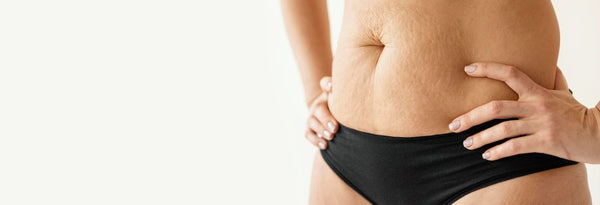All About Stretch Marks: Answers to Your Questions

Medically Reviewed By:
Dr. Neeraj Bansal, BAMS
Written by Our Editorial Team
Stretch marks, those lines that can appear on our bodies, often bring up a lot of questions. Whether you're experiencing them due to growth spurts, weight gain, or pregnancy, understanding stretch marks can help you navigate how to deal with them and, potentially, how to reduce their appearance. This comprehensive guide will delve into the most common questions about stretch marks, offering insights and advice on this widespread concern.
| Also Read: How Long Does It Take To See Results With Natural Stretch Mark Cream? |
What Are Stretch Marks?
Stretch marks, medically known as striae distensae, are a form of scarring on the skin with an off-color hue. They are caused by tearing of the dermis during periods of rapid growth of the body, such as during puberty, pregnancy, or muscle growth. Initially, they may appear as reddish or purplish lines, but over time, they fade to a lighter range.

Why Do Stretch Marks Occur?
The skin consists of three main layers: the epidermis (outer layer), the dermis (middle layer), and the subcutaneous or hypodermic (deepest layer). Stretch marks form in the dermis when the connective tissue is stretched beyond the limits of its elasticity due to rapid expansion or contraction of the skin. This is often due to rapid growth or weight gain that outpaces the production of new collagen, making the skin lose its elasticity and resulting in fine tears.
Who Gets Stretch Marks?
Anyone can develop stretch marks, regardless of gender or age, but they are more common in certain conditions such as: - Pregnancy: About 50-90% of pregnant women will develop stretch marks before delivery.
- Adolescence: Rapid growth during puberty often results in stretch marks.
- Weight gain: Sudden weight gain can cause stretch marks, as can conditions that lead to rapid weight gain like certain medical disorders or medications.
- Bodybuilding: Rapid muscle growth can stretch the skin beyond its elasticity.
Can You Prevent Stretch Marks?
While it's not always possible to prevent stretch marks completely due to factors like genetics and the normal stretching of the skin during periods of rapid growth, there are measures you can take to reduce your risk: -
- Maintain a healthy lifestyle: Keeping your weight in a healthy range by eating a balanced diet and exercising regularly can help manage your skin's elasticity.
- Stay hydrated: Drinking enough water maintains hydration in the skin, which may improve its elasticity.
- Nutritious diet: Eating foods rich in vitamins C, D, E, zinc, and protein can support skin health and may help keep your skin strong.
- Moisturize: Regular use of moisturizers can keep the skin supple and may improve its elasticity.
How Can You Treat Stretch Marks?
While stretch marks are a natural part of many life stages and don't require treatment for medical reasons, there are ways to reduce their appearance if they bother you:-
- Topical treatments: Retinoid creams, hyaluronic acid, and glycolic acid can sometimes reduce the appearance of stretch marks. However, these treatments are more effective on newer stretch marks.
- Laser therapy: Various forms of laser therapy stimulate collagen or elastin production in your skin, helping to restore the tissue's structure and appearance.
- Microneedling: This involves rolling a needle-studded device over the skin to stimulate collagen formation.
- Cosmetic surgery: In cases of significant body changes, such as after major weight loss, surgical options like a tummy tuck might remove the skin with stretch marks.
| Must Read: Tips To Prevent Stretch Marks During Pregnancy |
Introducing POKONUT Stretch Mark Cream
One promising product for those seeking a natural approach to managing stretch marks is POKONUT stretch mark cream. Formulated with natural and organic ingredients known for their skin-healing properties, POKONUT cream aims to hydrate, nourish, and improve the skin's elasticity, potentially reducing the visibility of stretch marks.
- Key Ingredients: POKONUT stretch mark cream is enriched with ingredients like Hyaluronic Acid, Rosehip Oil, Licorice Root, and Vitamin E, each selected for their ability to support skin health and repair.
- How It Works: The combination of hydrating and regenerative ingredients works to moisturize the skin deeply, improve elasticity, and promote the healing of the skin's middle layer, where stretch marks form.
- User Experience: Many users appreciate the cream's natural formulation, reporting improvements in the appearance of stretch marks with consistent use. Its gentle, hydrating properties make it suitable for all skin types, including sensitive skin.
Are Stretch Marks Harmful?
Medically, stretch marks are not harmful; they are purely a cosmetic issue. They do not cause any long-term health problems but can be a source of anxiety or self-consciousness for some people.
How Long Do Stretch Marks Last?
Stretch marks are permanent in the sense that they do not disappear completely. However, they can significantly diminish in appearance over time. Fresh stretch marks, which are usually red or purple, will gradually fade to silver or white and become much less noticeable.
Do Stretch Marks Get Worse Over Time?
Without treatment, stretch marks can remain visible, though they often become less pronounced as they age. Factors like ongoing stress on the skin, such as continued weight gain or pregnancy, can exacerbate or add new stretch marks.
Can Men Get Stretch Marks?
Yes, men can and do get stretch marks. Rapid growth during adolescence, significant weight gain, or intense bodybuilding can all cause stretch marks to form.
Does Every Pregnant Woman Get Stretch Marks?
While a large percentage of pregnant women develop stretch marks, not everyone does. Genetics plays a significant role, and so does the amount of weight gained during pregnancy.
Are There Any Home Remedies?
Several home remedies are believed to reduce the appearance of stretch marks, though scientific evidence to support their effectiveness is limited:
- Aloe Vera: Known for its healing and soothing properties, aloe vera can be applied directly to the affected area.
- Coconut Oil:Regular application of coconut oil is said to reduce stretch marks by moisturizing the skin and increasing its elasticity.
- Sugar Scrub: A homemade sugar scrub used as an exfoliant can sometimes improve the appearance of stretch marks by removing dead skin cells.
Conclusion
Stretch marks are a common, if unwelcome, part of many people's lives, reflecting periods of growth and change. While they can't always be prevented or erased, understanding what they are and how you can manage their appearance can help you feel more in control and less self-conscious. Whether you choose to embrace them or treat them, remember that stretch marks are just one part of your unique story.
About Doctor :













3 Comments
Leave a comment
Please note, comments need to be approved before they are published.